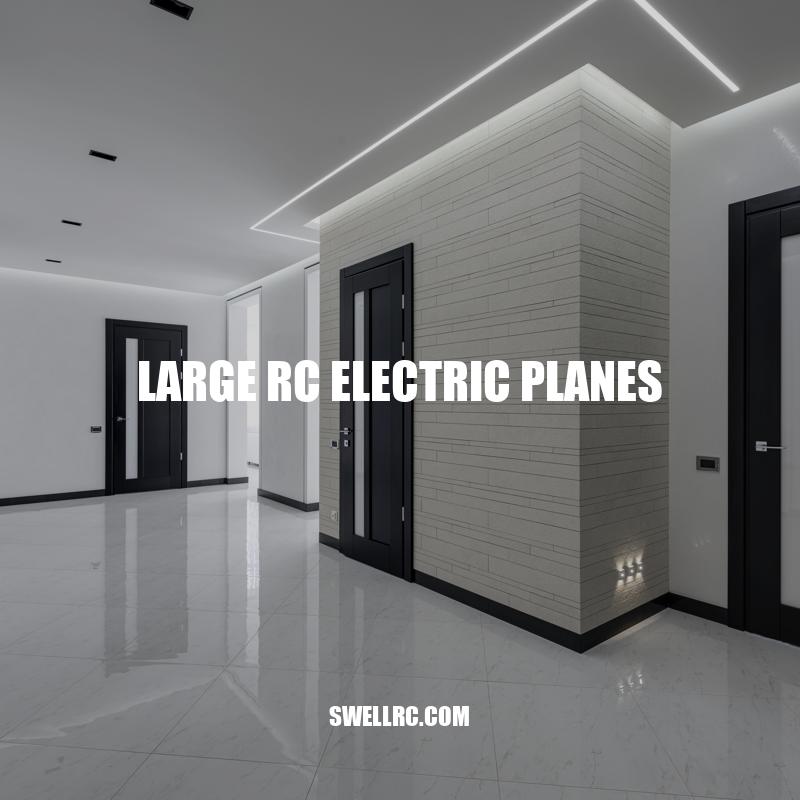Exploring Large RC Electric Planes: Advantages, Types, and Flying Tips.
Large RC electric planes have captured the attention of RC enthusiasts worldwide. These aircraft are powered by clean and renewable energy sources while offering thrilling flying experiences. Compared to their gas-powered counterparts, these planes are environmentally friendly, efficient, and longer-lasting. Pilots can now enjoy flying for longer periods without worrying about the costs of replacing fuel and other components. What’s more, large RC electric planes boast of larger wingspans and exceptional stability due to their innovative designs. This stability enables the plane to fly in adverse weather conditions and also makes flying more comfortable for amateur pilots. The planes also come with advanced electronics that make it easier for pilots to maneuver both in the air and on the ground. As a result, these planes continue to gain popularity among pilots interested in sports, recreation, and competitive flying. In this article, we will explore the world of large RC electric planes and provide an insight into what makes these planes so attractive to many pilots worldwide.
Large RC electric planes offer an outstanding flying experience that is not possible with other types of planes. The following are the advantages of large RC electric planes:
- Environmentally friendly – They run on clean and renewable energy sources, which means they emit no harmful gases.
- Larger wingspans – This gives the planes more stability and better lift, making flying more comfortable and more accessible for hobby pilots.
- Increased flight times – The planes can stay in the air for longer periods, allowing pilots to enjoy longer flights.
- Advanced electronics – The planes come with advanced electronics that make them easy to control and more maneuverable.
- Low operating costs – Electric planes require less maintenance, and the batteries can be recharged multiple times, which reduces costs associated with gas and oil fuels.
RC enthusiasts can purchase large RC electric planes online or at local hobby shops. Some of the trusted websites for purchasing these planes include Horizon Hobby, RC Universe, and Motion RC. Additionally, online communities such as RCGroups provide an opportunity for pilots to discuss the planes, ask for advice and share their experiences.
Are bigger RC planes easier to fly?
When it comes to RC planes, beginners often wonder if a bigger plane is easier to fly than a smaller one. The fact is, the size of an RC plane does not determine its overall ease of flight. There are other important factors that determine how easy an RC plane is to fly, which include the wingspan, weight balance, and design.
Generally, larger planes do tend to be more stable in flight. This is because they have more weight, and their larger wingspan helps with better lift, making them more resistant to turbulence.
However, bigger planes can be a bit harder to maneuver, especially for beginners who may have limited experience in controlling RC planes. The bigger size means that it needs a larger open space to fly around in, and the increased weight can make it harder to control in tight turns or landings.
On the other hand, smaller planes are more nimble and easier to control. They can fly indoors as well as in smaller outdoor areas, making them more convenient for beginners to learn with. However, small planes may be more sensitive to winds and turbulence, making them a bit harder to fly in challenging conditions.
In conclusion, the size of the RC plane does not necessarily dictate its ease of flight. Instead, it mainly depends on the plane’s overall design, weight balance, and wingspan. Whether you are a beginner or an experienced pilot, it is important to choose a plane that suits your level of experience and the type of flying you want to do.
Types of Large RC Electric Planes
There are various types of large RC electric planes available in the market to cater to different skill levels and personal preferences. Some of these types are:
| Type | Description |
|---|---|
| Aerobatic planes | Designed for performing aerial maneuvers such as flips, rolls, and loops, these planes are sturdily built and excellent for experienced pilots. |
| Giant-scale planes | These planes model larger planes and provide an immersive experience. They can range between 6-10 feet in wingspan and require a lot of space for flying. |
| Sport planes | These planes are designed for recreational flying and can perform basic aerobatics. They are beginner-friendly and sturdy. |
| Scale planes | These planes are designed to look like a specific real plane. They can provide an authentic flying experience and also serve as collectibles for enthusiasts. |
RC enthusiasts can purchase large RC electric planes to build from kits or purchase ready-to-fly planes. Some popular websites that offer a range of scale model aircraft, including large RC electric planes, include Motion RC, Tower Hobbies, and Horizon Hobby. Typically, ready-to-fly planes come with all the components pre-installed and are easy to assemble, while building a kit would provide a higher degree of personalization. These planes can range from several hundred dollars to over a thousand dollars, depending on factors like size, quality, and complexity.
How big is the biggest RC plane?
The largest RC plane ever built was a model of the Antonov An-225 Mriya, which happens to be the largest cargo plane in the world. The RC version of the aircraft had an impressive wingspan of 27 feet and weighed around 265 pounds! It was built by a team of RC hobbyists and took nearly 6 years to complete. The giant RC plane was powered by six jet engines and could reach a maximum speed of 100mph. It required a team of more than 12 people to operate it and had to be flown in an open area due to its massive size. Despite the challenges faced while building and operating the giant plane, it remains a monumental achievement in the world of RC aircraft.
How to Build a Large RC Electric Plane
Building an RC plane can be a fun and rewarding experience. Here are some steps to follow when building a large RC electric plane:
- Choose a design: Look for a design that suits your skill level, flying style, and the components you have access to. Check the plan’s completeness, size, and publication date before ordering it.
- Order parts: Once you have a plan, order the necessary components from suppliers or manufacturers. You may need to consider purchasing a radio control system, receiver, motor, and battery, among others.
- Assemble: Assemble the components by bolting and gluing the parts together per the instructions that come with the plan. You may need to make modifications to suit your build or flying preferences.
- Test: Check the weight and balance of the large RC electric plane. Make modifications as necessary before the first flight. You may also want to consider testing the plane in a computer simulator before hand-launching it.
- Flying: Make your first flight a short one, about six to ten seconds. Gradually increase the throttle as you get comfortable with the plane. Cut the power, and let the airplane glide in for a landing.
Building an RC plane may require access to specialized tools and equipment. Some hobby stores offer workshops or classes for learners to get hands-on experience in building RC models. Additionally, some websites offer kits and components for building large RC electric planes, such as HobbyKing, Amazon, and Horizon Hobby. The cost of building an RC plane ranges from a few hundred to several thousand dollars, depending on the model’s size and complexity.
How much does it cost to build a RC plane?
Building a remote control (RC) plane can be a thrilling and rewarding experience for aviation enthusiasts. However, before embarking on the journey to build an RC plane, the cost needs to be considered.
The cost of building an RC plane can vary greatly and is influenced by several factors such as the size and complexity of the aircraft, the type and quality of materials used, and the tools needed.
For beginners, it’s recommended to start with a simpler design that requires less expensive materials. A basic foam board RC plane can cost anywhere from $50 to $150, while a higher-end balsa wood or carbon fiber model can cost upwards of $500.
One should consider investing in good quality equipment that will last longer, such as a reliable radio transmitter, batteries, and battery chargers. The cost of these items alone can range from $100 to $400.
Other optional costs include accessories and tools such as adhesives, paints, decal sheets, and sandpaper. These items can set you back anywhere from $20 to $50.
It’s essential to keep in mind that the cost of building an RC plane can add up quickly. However, it’s also possible to save some money by repurposing some of the materials and equipment that you already have or by purchasing affordable used items.
Ultimately, the cost of building an RC plane depends on individual preferences, goals, and needs. But one thing is sure, the experience of building and flying one will be priceless.
Flying Large RC Electric Planes
Flying a large RC electric plane successfully requires caution, experience, and proper preparation. Here are some critical aspects to keep in mind:
- Weather conditions: Check the weather forecast before flying and avoid windy, snowy, or rainy conditions. For best results, fly in calm and clear weather.
- Battery power: Check the battery’s power level before flying and bring extra batteries as needed. Discharging the battery below the recommended levels may damage the battery or the airplane.
- Location: Choose a location conducive to flying an RC plane, such as a large open field or a flying club. Avoid flying near people, animals, or other objects that could cause interference.
- Pre-flight checks: Conduct a pre-flight check to ensure the plane is ready for flying, including checking the control surfaces, motor, battery, and receiver. Also, check the air traffic control for flying restrictions and flight paths.
- Flying: Start with slow throttle speeds and gradually increase speed as you get comfortable with the plane. Keep the plane at a safe altitude and maintain control of the airplane at all times. Avoid performing high-speed or complex acrobatic moves if you’re new to flying.
- Post-flight checks: Inspect the plane for any damage after the flight, check the batteries, and clean the plane as necessary.
Before flying an RC airplane, make sure to review the FAA’s safety guidelines for drone pilots. Additionally, you may want to consider joining an RC club or participating in community events to learn from experienced pilots. Some popular online resources for RC flyers include RC Groups, RC Universe, and Flite Test. These websites provide communities, forums, tutorials, and product reviews for RC model enthusiasts.
Conclusion
In conclusion, large RC electric planes are a rapidly growing segment of the RC plane community. These planes offer a unique flying experience that is not easily matched by traditional gas-powered planes. They are also eco-friendly, making them an excellent option for pilots who want to fly without harming the environment. Whether you’re a novice or an experienced pilot, flying large RC electric planes is an enjoyable and rewarding hobby that can provide hours of entertainment.
With advances in technology, the cost and complexity of building and flying these planes have decreased, making them more accessible to a wider audience. As a result, more RC enthusiasts are switching to electric-powered planes for their flying experiences. Whether you want to fly for fun or competition, a large RC electric plane is an excellent choice. With safety precautions and proper knowledge, you can have an enjoyable and safe flying experience that you will remember for years to come.



